Xianghui Yang
refer to the report for detailed contributions
Unleashing Vecset Diffusion Model for Fast Shape Generation
Mar 20, 2025Abstract:3D shape generation has greatly flourished through the development of so-called "native" 3D diffusion, particularly through the Vecset Diffusion Model (VDM). While recent advancements have shown promising results in generating high-resolution 3D shapes, VDM still struggles with high-speed generation. Challenges exist because of difficulties not only in accelerating diffusion sampling but also VAE decoding in VDM, areas under-explored in previous works. To address these challenges, we present FlashVDM, a systematic framework for accelerating both VAE and DiT in VDM. For DiT, FlashVDM enables flexible diffusion sampling with as few as 5 inference steps and comparable quality, which is made possible by stabilizing consistency distillation with our newly introduced Progressive Flow Distillation. For VAE, we introduce a lightning vecset decoder equipped with Adaptive KV Selection, Hierarchical Volume Decoding, and Efficient Network Design. By exploiting the locality of the vecset and the sparsity of shape surface in the volume, our decoder drastically lowers FLOPs, minimizing the overall decoding overhead. We apply FlashVDM to Hunyuan3D-2 to obtain Hunyuan3D-2 Turbo. Through systematic evaluation, we show that our model significantly outperforms existing fast 3D generation methods, achieving comparable performance to the state-of-the-art while reducing inference time by over 45x for reconstruction and 32x for generation. Code and models are available at https://github.com/Tencent/FlashVDM.
PBR3DGen: A VLM-guided Mesh Generation with High-quality PBR Texture
Mar 14, 2025Abstract:Generating high-quality physically based rendering (PBR) materials is important to achieve realistic rendering in the downstream tasks, yet it remains challenging due to the intertwined effects of materials and lighting. While existing methods have made breakthroughs by incorporating material decomposition in the 3D generation pipeline, they tend to bake highlights into albedo and ignore spatially varying properties of metallicity and roughness. In this work, we present PBR3DGen, a two-stage mesh generation method with high-quality PBR materials that integrates the novel multi-view PBR material estimation model and a 3D PBR mesh reconstruction model. Specifically, PBR3DGen leverages vision language models (VLM) to guide multi-view diffusion, precisely capturing the spatial distribution and inherent attributes of reflective-metalness material. Additionally, we incorporate view-dependent illumination-aware conditions as pixel-aware priors to enhance spatially varying material properties. Furthermore, our reconstruction model reconstructs high-quality mesh with PBR materials. Experimental results demonstrate that PBR3DGen significantly outperforms existing methods, achieving new state-of-the-art results for PBR estimation and mesh generation. More results and visualization can be found on our project page: https://pbr3dgen1218.github.io/.
Nautilus: Locality-aware Autoencoder for Scalable Mesh Generation
Jan 27, 2025



Abstract:Triangle meshes are fundamental to 3D applications, enabling efficient modification and rasterization while maintaining compatibility with standard rendering pipelines. However, current automatic mesh generation methods typically rely on intermediate representations that lack the continuous surface quality inherent to meshes. Converting these representations into meshes produces dense, suboptimal outputs. Although recent autoregressive approaches demonstrate promise in directly modeling mesh vertices and faces, they are constrained by the limitation in face count, scalability, and structural fidelity. To address these challenges, we propose Nautilus, a locality-aware autoencoder for artist-like mesh generation that leverages the local properties of manifold meshes to achieve structural fidelity and efficient representation. Our approach introduces a novel tokenization algorithm that preserves face proximity relationships and compresses sequence length through locally shared vertices and edges, enabling the generation of meshes with an unprecedented scale of up to 5,000 faces. Furthermore, we develop a Dual-stream Point Conditioner that provides multi-scale geometric guidance, ensuring global consistency and local structural fidelity by capturing fine-grained geometric features. Extensive experiments demonstrate that Nautilus significantly outperforms state-of-the-art methods in both fidelity and scalability. The project page will be released to https://nautilusmeshgen.github.io.
Hunyuan3D 2.0: Scaling Diffusion Models for High Resolution Textured 3D Assets Generation
Jan 21, 2025



Abstract:We present Hunyuan3D 2.0, an advanced large-scale 3D synthesis system for generating high-resolution textured 3D assets. This system includes two foundation components: a large-scale shape generation model -- Hunyuan3D-DiT, and a large-scale texture synthesis model -- Hunyuan3D-Paint. The shape generative model, built on a scalable flow-based diffusion transformer, aims to create geometry that properly aligns with a given condition image, laying a solid foundation for downstream applications. The texture synthesis model, benefiting from strong geometric and diffusion priors, produces high-resolution and vibrant texture maps for either generated or hand-crafted meshes. Furthermore, we build Hunyuan3D-Studio -- a versatile, user-friendly production platform that simplifies the re-creation process of 3D assets. It allows both professional and amateur users to manipulate or even animate their meshes efficiently. We systematically evaluate our models, showing that Hunyuan3D 2.0 outperforms previous state-of-the-art models, including the open-source models and closed-source models in geometry details, condition alignment, texture quality, and etc. Hunyuan3D 2.0 is publicly released in order to fill the gaps in the open-source 3D community for large-scale foundation generative models. The code and pre-trained weights of our models are available at: https://github.com/Tencent/Hunyuan3D-2
TimeFormer: Capturing Temporal Relationships of Deformable 3D Gaussians for Robust Reconstruction
Nov 18, 2024Abstract:Dynamic scene reconstruction is a long-term challenge in 3D vision. Recent methods extend 3D Gaussian Splatting to dynamic scenes via additional deformation fields and apply explicit constraints like motion flow to guide the deformation. However, they learn motion changes from individual timestamps independently, making it challenging to reconstruct complex scenes, particularly when dealing with violent movement, extreme-shaped geometries, or reflective surfaces. To address the above issue, we design a plug-and-play module called TimeFormer to enable existing deformable 3D Gaussians reconstruction methods with the ability to implicitly model motion patterns from a learning perspective. Specifically, TimeFormer includes a Cross-Temporal Transformer Encoder, which adaptively learns the temporal relationships of deformable 3D Gaussians. Furthermore, we propose a two-stream optimization strategy that transfers the motion knowledge learned from TimeFormer to the base stream during the training phase. This allows us to remove TimeFormer during inference, thereby preserving the original rendering speed. Extensive experiments in the multi-view and monocular dynamic scenes validate qualitative and quantitative improvement brought by TimeFormer. Project Page: https://patrickddj.github.io/TimeFormer/
Scaling Mesh Generation via Compressive Tokenization
Nov 11, 2024



Abstract:We propose a compressive yet effective mesh representation, Blocked and Patchified Tokenization (BPT), facilitating the generation of meshes exceeding 8k faces. BPT compresses mesh sequences by employing block-wise indexing and patch aggregation, reducing their length by approximately 75\% compared to the original sequences. This compression milestone unlocks the potential to utilize mesh data with significantly more faces, thereby enhancing detail richness and improving generation robustness. Empowered with the BPT, we have built a foundation mesh generative model training on scaled mesh data to support flexible control for point clouds and images. Our model demonstrates the capability to generate meshes with intricate details and accurate topology, achieving SoTA performance on mesh generation and reaching the level for direct product usage.
Tencent Hunyuan3D-1.0: A Unified Framework for Text-to-3D and Image-to-3D Generation
Nov 05, 2024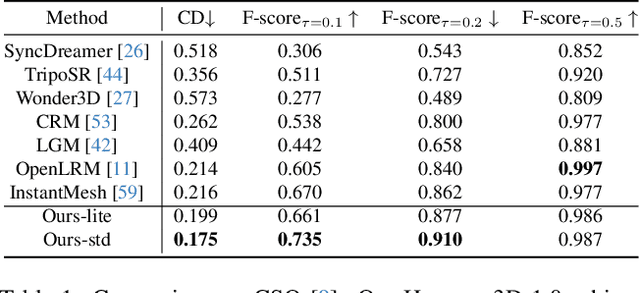

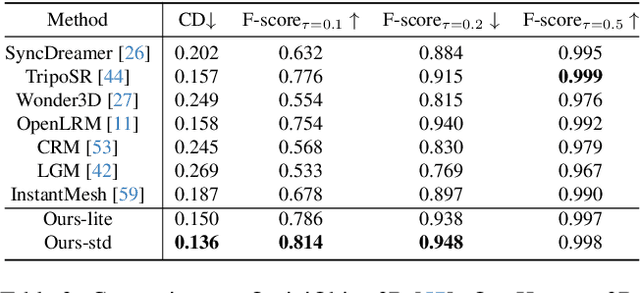

Abstract:While 3D generative models have greatly improved artists' workflows, the existing diffusion models for 3D generation suffer from slow generation and poor generalization. To address this issue, we propose a two-stage approach named Hunyuan3D-1.0 including a lite version and a standard version, that both support text- and image-conditioned generation. In the first stage, we employ a multi-view diffusion model that efficiently generates multi-view RGB in approximately 4 seconds. These multi-view images capture rich details of the 3D asset from different viewpoints, relaxing the tasks from single-view to multi-view reconstruction. In the second stage, we introduce a feed-forward reconstruction model that rapidly and faithfully reconstructs the 3D asset given the generated multi-view images in approximately 7 seconds. The reconstruction network learns to handle noises and in-consistency introduced by the multi-view diffusion and leverages the available information from the condition image to efficiently recover the 3D structure. Our framework involves the text-to-image model, i.e., Hunyuan-DiT, making it a unified framework to support both text- and image-conditioned 3D generation. Our standard version has 3x more parameters than our lite and other existing model. Our Hunyuan3D-1.0 achieves an impressive balance between speed and quality, significantly reducing generation time while maintaining the quality and diversity of the produced assets.
ViewFusion: Towards Multi-View Consistency via Interpolated Denoising
Feb 29, 2024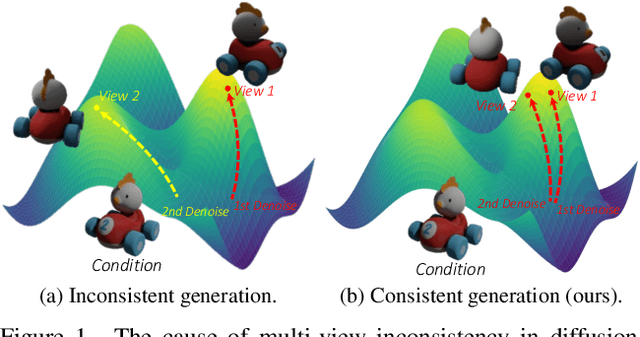
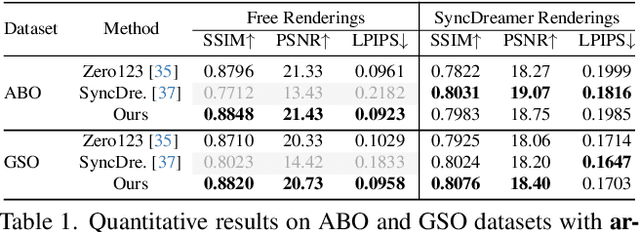
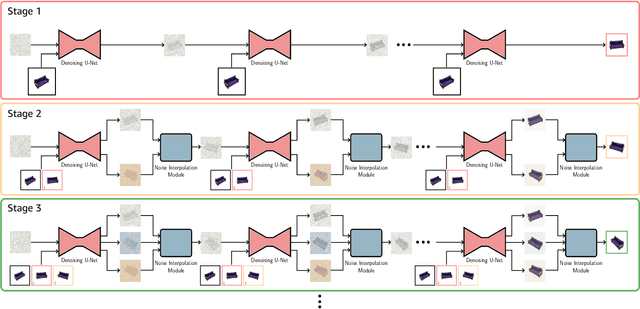
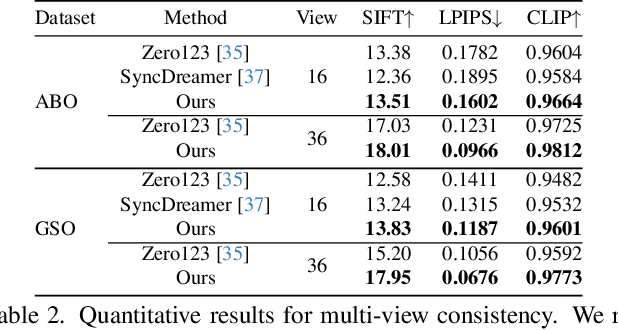
Abstract:Novel-view synthesis through diffusion models has demonstrated remarkable potential for generating diverse and high-quality images. Yet, the independent process of image generation in these prevailing methods leads to challenges in maintaining multiple-view consistency. To address this, we introduce ViewFusion, a novel, training-free algorithm that can be seamlessly integrated into existing pre-trained diffusion models. Our approach adopts an auto-regressive method that implicitly leverages previously generated views as context for the next view generation, ensuring robust multi-view consistency during the novel-view generation process. Through a diffusion process that fuses known-view information via interpolated denoising, our framework successfully extends single-view conditioned models to work in multiple-view conditional settings without any additional fine-tuning. Extensive experimental results demonstrate the effectiveness of ViewFusion in generating consistent and detailed novel views.
Neural Vector Fields: Generalizing Distance Vector Fields by Codebooks and Zero-Curl Regularization
Sep 04, 2023



Abstract:Recent neural networks based surface reconstruction can be roughly divided into two categories, one warping templates explicitly and the other representing 3D surfaces implicitly. To enjoy the advantages of both, we propose a novel 3D representation, Neural Vector Fields (NVF), which adopts the explicit learning process to manipulate meshes and implicit unsigned distance function (UDF) representation to break the barriers in resolution and topology. This is achieved by directly predicting the displacements from surface queries and modeling shapes as Vector Fields, rather than relying on network differentiation to obtain direction fields as most existing UDF-based methods do. In this way, our approach is capable of encoding both the distance and the direction fields so that the calculation of direction fields is differentiation-free, circumventing the non-trivial surface extraction step. Furthermore, building upon NVFs, we propose to incorporate two types of shape codebooks, \ie, NVFs (Lite or Ultra), to promote cross-category reconstruction through encoding cross-object priors. Moreover, we propose a new regularization based on analyzing the zero-curl property of NVFs, and implement this through the fully differentiable framework of our NVF (ultra). We evaluate both NVFs on four surface reconstruction scenarios, including watertight vs non-watertight shapes, category-agnostic reconstruction vs category-unseen reconstruction, category-specific, and cross-domain reconstruction.
Neural Vector Fields: Implicit Representation by Explicit Learning
Mar 08, 2023Abstract:Deep neural networks (DNNs) are widely applied for nowadays 3D surface reconstruction tasks and such methods can be further divided into two categories, which respectively warp templates explicitly by moving vertices or represent 3D surfaces implicitly as signed or unsigned distance functions. Taking advantage of both advanced explicit learning process and powerful representation ability of implicit functions, we propose a novel 3D representation method, Neural Vector Fields (NVF). It not only adopts the explicit learning process to manipulate meshes directly, but also leverages the implicit representation of unsigned distance functions (UDFs) to break the barriers in resolution and topology. Specifically, our method first predicts the displacements from queries towards the surface and models the shapes as \textit{Vector Fields}. Rather than relying on network differentiation to obtain direction fields as most existing UDF-based methods, the produced vector fields encode the distance and direction fields both and mitigate the ambiguity at "ridge" points, such that the calculation of direction fields is straightforward and differentiation-free. The differentiation-free characteristic enables us to further learn a shape codebook via Vector Quantization, which encodes the cross-object priors, accelerates the training procedure, and boosts model generalization on cross-category reconstruction. The extensive experiments on surface reconstruction benchmarks indicate that our method outperforms those state-of-the-art methods in different evaluation scenarios including watertight vs non-watertight shapes, category-specific vs category-agnostic reconstruction, category-unseen reconstruction, and cross-domain reconstruction. Our code will be publicly released.
 Add to Chrome
Add to Chrome Add to Firefox
Add to Firefox Add to Edge
Add to Edge